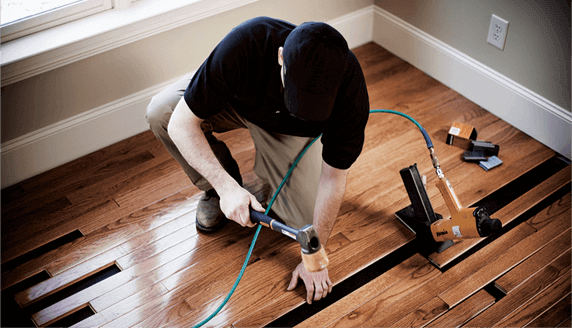Flooring is an integral part of any interior design project, contributing not only to the aesthetics but also to the functionality and comfort of a space. Whether you’re renovating your home or designing a new one, choosing the right flooring is crucial. In this comprehensive guide, we’ll walk you through everything you need to know about flooring services, offering valuable advice and design tips to help you make informed decisions.
Introduction to Flooring Services
Flooring plays a significant role in setting the tone for a room. It serves as the foundation upon which the rest of the interior design is built. From hardwood and laminate to tile and carpet, there are numerous options available, each with its own unique characteristics and benefits.
Choosing the Right Flooring Material
When selecting flooring for your home, it’s essential to consider factors such as durability, maintenance requirements, and aesthetic appeal. Different materials offer varying levels of resilience and style options, making it important to assess your needs and preferences before making a decision.
Factors to Consider
Before diving into specific flooring materials, assess the traffic patterns, moisture levels, and maintenance preferences of the space where the flooring will be installed.
Types of Flooring Materials
- Hardwood: Known for its timeless elegance and durability, hardwood flooring adds warmth and character to any room.
- Laminate: A cost-effective alternative to hardwood, laminate flooring mimics the look of wood while offering easy installation and maintenance.
- Tile: Available in a variety of materials such as ceramic, porcelain, and natural stone, tile flooring is highly durable and resistant to moisture.
- Vinyl: Versatile and budget-friendly, vinyl flooring comes in an array of styles, including planks and tiles, offering endless design possibilities.
- Carpet: Soft and comfortable underfoot, carpeting provides warmth and sound insulation, making it ideal for bedrooms and living areas.
Flooring Installation Process
Installing new flooring requires careful planning and execution to ensure a flawless result. While some homeowners may opt for a DIY approach, hiring professional flooring services guarantees quality workmanship and peace of mind.
Preparation Steps
Before installation begins, it’s essential to prepare the subfloor, ensuring it’s clean, level, and free of any debris or imperfections.
Installation Techniques
The installation method varies depending on the type of flooring material chosen. From floating floors to glue-down installations, each technique requires specific tools and expertise.
Hiring Professional Services vs. DIY
While DIY installations may seem cost-effective, hiring experienced professionals can save time and prevent costly mistakes. Professional installers have the skills and equipment needed to handle even the most challenging flooring projects.
Flooring Design Tips
In addition to selecting the right material, paying attention to design details can elevate the look of your space. Consider the following tips when planning your flooring design:
Color and Texture Considerations
Choose flooring colors and textures that complement the overall aesthetic of your home. Lighter colors can make a room feel more spacious, while textured finishes add depth and visual interest.
Layout and Pattern Ideas
Experiment with different layout patterns, such as herringbone or basket weave, to create visual impact. Mix and match flooring materials to define separate areas within an open-concept space.
Incorporating Flooring into Overall Design Scheme
Coordinate flooring choices with other design elements, such as wall colors, furniture, and decor accessories, to achieve a cohesive look throughout your home.
Maintenance and Care
Once your new flooring is installed, proper maintenance is essential to preserve its beauty and longevity. Implementing a regular cleaning routine and addressing minor issues promptly can prevent costly repairs down the line.
Routine Cleaning Practices
Follow manufacturer guidelines for cleaning and maintenance, using appropriate products and techniques to avoid damage to the flooring surface.
Preventive Maintenance Tips
Place rugs or mats in high-traffic areas to protect flooring from wear and tear. Trim pet nails regularly to prevent scratches, and avoid exposing hardwood floors to excessive moisture.
Dealing with Common Issues
From scratches and stains to water damage and warping, knowing how to address common flooring issues can extend the lifespan of your floors. Consult with flooring professionals for expert advice and repairs when needed.
Flooring Trends and Innovations
As interior design trends evolve, so do flooring options. Stay up to date with the latest innovations and design trends to ensure your home remains stylish and functional.
Emerging Trends in Flooring Design
From eco-friendly materials to bold patterns and colors, explore the latest trends shaping the world of flooring design.
Innovative Flooring Technologies
Advancements in flooring technology, such as waterproof laminates and luxury vinyl planks, offer enhanced durability and performance for modern homes.
Eco-Friendly Flooring Options
For environmentally conscious homeowners, eco-friendly flooring options provide a sustainable alternative to traditional materials.
Sustainable Materials
Choose flooring materials made from renewable resources, such as bamboo or cork, to minimize environmental impact.
Benefits of Eco-Friendly Flooring
In addition to reducing carbon footprint, eco-friendly flooring options often boast superior durability and indoor air quality benefits.
Popular Eco-Friendly Choices
Explore eco-friendly flooring options ranging from reclaimed wood and recycled glass to natural linoleum and wool carpeting.
Budgeting for Flooring Projects
Before embarking on a flooring project, it’s crucial to establish a realistic budget and explore cost-saving strategies.
Cost Factors to Consider
Consider factors such as material costs, installation fees, and additional expenses for subfloor preparation and removal of old flooring.
Setting a Realistic Budget
Determine your budget based on the square footage of the space and the quality of materials and labor required.
Ways to Save Money on Flooring Projects
Shop around for competitive pricing, consider alternative materials, and explore DIY options to stretch your budget further.
Hiring a Flooring Contractor
When entrusting your flooring project to professionals, it’s essential to research reputable contractors and ask the right questions.
Researching Reputable Contractors
Read reviews, check credentials, and request quotes from multiple contractors to ensure you’re making an informed decision.
Questions to Ask During Consultations
Inquire about experience, warranties, and timelines to gauge the contractor’s expertise and professionalism.
Checking References and Credentials
Ask for references and photos of past projects to assess the quality of workmanship and customer satisfaction.
Flooring for Different Spaces
Not all flooring materials are created equal, and certain options are better suited for specific rooms within your home.
Best Flooring Options for Specific Rooms
Consider the unique requirements of each space when selecting flooring materials, ensuring durability, water resistance, and comfort where needed.
Living Room
Opt for durable and stylish flooring options that can withstand heavy foot traffic and frequent use.
Kitchen
Choose waterproof and easy-to-clean flooring materials, such as tile or luxury vinyl, to handle spills and messes common in kitchen environments.
Bathroom
Prioritize moisture-resistant flooring options, such as porcelain tile or vinyl plank, to prevent water damage and mold growth in bathrooms.
Bedroom
Create a cozy and inviting atmosphere with soft carpeting or warm hardwood flooring that enhances comfort and relaxation.
Basement
Select moisture-resistant flooring materials, such as engineered wood or epoxy coatings, to prevent water damage and humidity issues in basements.
Addressing Flooring Challenges
From uneven subfloors to damaged flooring, addressing common challenges is essential to achieving a flawless finish.
Dealing with Uneven Surfaces
Level uneven subfloors before installation to ensure a smooth and stable foundation for your new flooring.
Repairing Damaged Flooring
Whether it’s scratches, dents, or water damage, addressing flooring issues promptly can prevent further deterioration and costly repairs.
Upgrading Outdated Flooring
Give your home a fresh look by replacing outdated flooring with modern options that reflect your style and personality.
DIY Flooring Tips and Tricks
For those who enjoy tackling home improvement projects, DIY flooring installations can be a rewarding endeavor.
Tools and Equipment Needed
Invest in quality tools, such as a flooring nailer or tile cutter, and familiarize yourself with installation techniques before starting your project.
Step-by-Step Installation Guides
Follow manufacturer instructions and online tutorials to ensure proper installation and avoid common pitfalls.
Common Mistakes to Avoid
From improper subfloor preparation to incorrect measurements, learn from others’ mistakes to achieve professional results.
Enhancing Safety with Flooring Choices
In addition to aesthetics and durability, safety should also be a priority when selecting flooring materials.
Slip-Resistant Options
Choose flooring materials with textured surfaces or non-slip coatings to reduce the risk of slips and falls, especially in high-traffic areas.
Impact on Indoor Air Quality
Opt for low-VOC or formaldehyde-free flooring options to maintain healthy indoor air quality and minimize off-gassing.
Child and Pet-Friendly Flooring
Select flooring materials that are scratch-resistant and easy to clean, ensuring a safe and comfortable environment for children and pets.
Customization and Personalization
Make a statement with custom flooring designs that reflect your unique style and personality.
Custom Design Options
Explore custom flooring options, such as inlays, borders, and medallions, to add a personal touch to your space.
Incorporating Personal Style Preferences
From traditional to contemporary, choose flooring materials and finishes that complement your existing decor and reflect your individual taste.
Unique Flooring Solutions
Think outside the box and consider unconventional materials, patterns, and layouts to create a one-of-a-kind flooring design.
Conclusion
Choosing the right flooring for your home is a decision that requires careful consideration of various factors, from aesthetics and durability to budget and maintenance requirements. By following the advice and design tips outlined in this guide, you can confidently navigate the world of flooring services and create a space that is both beautiful and functional. When exploring flooring services in Wellington NZ, ensure to consider the unique offerings and expertise of local flooring services.




